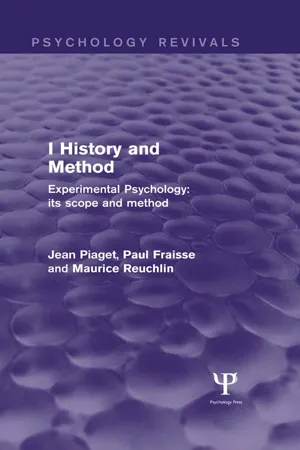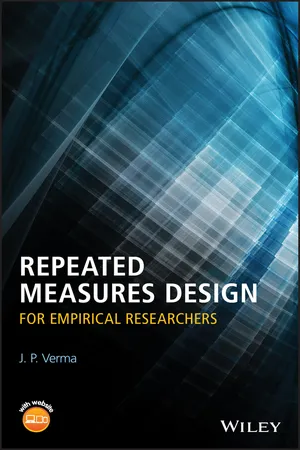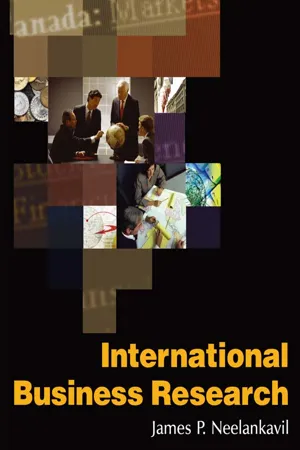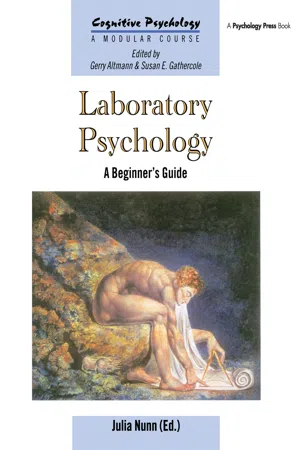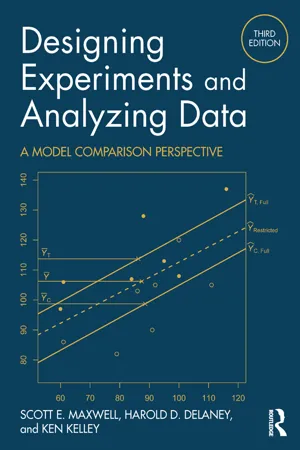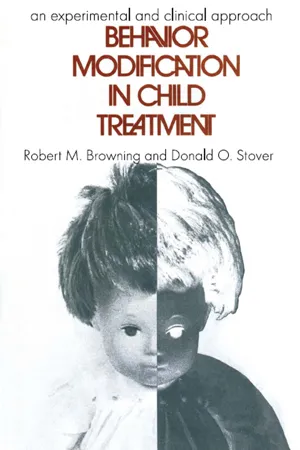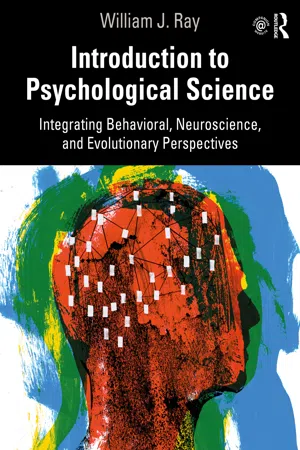Psychology
Experimental Method
The experimental method in psychology involves conducting controlled experiments to investigate cause-and-effect relationships between variables. It typically includes manipulating an independent variable and measuring its effects on a dependent variable. This method allows researchers to establish causal relationships and make inferences about the impact of specific factors on behavior or mental processes.
Written by Perlego with AI-assistance
Related key terms
11 Key excerpts on "Experimental Method"
- eBook - ePub
Essentials of Social Psychology
An Indian Perspective
- Shubhra Mangal, Shashi Mangal(Authors)
- 2022(Publication Date)
- Routledge(Publisher)
experimentum meaning ‘a trial’ or ‘test’. Therefore, in experimentation we try or put to the test the material or phenomenon whose characteristics or consequences (here the social behavior of the people) which we wish to ascertain. In the sciences, while conducting such experiments in the laboratory or field we may want to learn the effect of friction on motion, the effect of sunlight on growth of plants, etc. In social psychology also, we perform such experiments in the laboratory or outside the laboratory in the social environment – physical or social settings – to study the cause-effect relationship regarding the nature of human social behavior, i.e., the effect of anxiety, drugs or stresses on human social behavior, the effect of media violence on the audience and spectator violence, etc. In performing all such experiments, we try to establish certain cause and effect relationships through objective observations of the actions performed and the subsequent changes produced under pre-arranged or rigidly controlled conditions. From these observations certain conclusions are drawn and theories or principles are formulated.It is a widely used and most favored method of investigation employed by the social psychologists all over the globe for the study of the social behavior of the people. According to Higbee et al. (1982), social psychologists have used Experimental Method in about three-fourths of their research studies. Their choice has some merit as the Experimental Method may be said to comply with all the requirements needed for a method being called as a scientific method, namely as follows:- It provides an opportunity to carry out the experimental work for the researchers to make the most careful systematic observations of the behavior of the people in the quite controlled conditions otherwise unavailable with the use of other methods of investigation.
- It provides scope for the prediction of the behavior of the people by establishing a cause and effect relationship between two variables (the things and phenomenon that stand to vary and change in the social environment) related to the social behavior of the people.
Experimentation MethodThe research method aimed at establishing the possible cause and effect relationship between the independent and dependent variables of the study through some systematic and well-planned observations carried out under controlled conditions.Understood in this way experimentation method, in the shape of a formal definition, may be termed as a type of research method aimed at establishing the possible cause and effect relationship between variables (changeable or variable aspects of the social world) under study through some systematic and well-planned observations carried out under controlled conditions.In this definition, we have mentioned a few terms like variables, controlling of experimental conditions, etc. for the employment of Experimental Method on the part of investigators. Let us examine them. - eBook - ePub
- Jean Piaget, Paul Fraisse, Maurice Reuchlin(Authors)
- 2014(Publication Date)
- Psychology Press(Publisher)
Chapter 2 The Experimental Method Paul Fraisse 1 The nature of the Experimental MethodExperimental psychology represents that body of knowledge acquired in psychology by the use of the Experimental Method. After a century of productiveness in the physical, natural and human sciences, this method no longer needs introduction. Moreover, it would be difficult to add anything to the work of Claude Bernard except that in each science the Experimental Method has its own procedures and rules, which are the outcome of difficulties encountered and overcome by past workers. We propose to try and explain the specific problems of the experimental approach in psychology.Whatever the actual subject matter of each experimental procedure may be the method remains the same in principle. Although the experimenter’s first move must be guided by the fact, he will not be satisfied with that. His aim is to discover new facts,1 and he cannot do this unless he knows all the conditions governing their appearance. At that particular moment he is capable of foresight. But to achieve this end, the experimenter had had to connect together the intricate relationships between the essential facts, and the more complex his object the longer and more difficult the task will have been.It is a matter of disentangling a thread and of proceeding by stages in order to succeed. Each stage is characterized by the establishment of a relation between two or more facts . The graduated network of these relations constitutes the body of a science.The Experimental Method is really only a way of acquiring knowledge. Its essential feature is to maintain the coherence of a system of relations controlled by the experiment. This mode of knowledge is essentially distinct from that of philosophy, which is based on the evidence of propositions and the demands of reflexive thought, and culminates in a system of knowledge as coherent as possible. Its reasoning is directed by the laws of thought, while in science, this control is ensured by empirical verification. It is nevertheless true that the experimenter’s task does not consist merely of recording facts or even relations. Scientific activity is also the work of thought and, as Claude Bernard showed, we must be concerned less with method than with experimental reasoning. The fact is invoked or elicited essentially to verify the hypothesis set up by the experimenter. ‘A fact is nothing by itself, it has value only through the idea to which it is attached or through the proof it furnishes’. (Claude Bernard, p. 93.) But what is a fact in psychology? Even the history of psychology is in a sense the history of answers to this question (see Chapter 1 - eBook - ePub
Applied Child Study
A Developmental Approach
- Anthony D. Pellegrini, David F. Bjorklund(Authors)
- 1998(Publication Date)
- Psychology Press(Publisher)
Despite this commonsense approach, there seems to be a “paradigm war” (Gage, 1989) raging between experimentalists and interpretive, naturalistic researchers, especially in the area of educational research. Although polemics are helpful at the beginning of major disagreements between groups so that they can each define themselves clearly, at this point we should recognize that there is no one “silver bullet” or crystal ball that will provide all the answers. We should draw what we can from each approach to help us better understand the complexities of childhood.SOME BASIC PREMISES OF Experimental MethodS
Whereas naturalistic approaches attempt to study children in the everyday environment, the experimental approach attempts to create an experimental, often contrived, environment in which to examine children. Aspects of the environment thought to affect children’s behavior are manipulated and controlled. Through manipulation and control researchers can make causal inferences about these manipulations.Experimental environments can be real classrooms, as in the cases of field experiments of curriculum and design (P.K.Smith & Connolly, 1980), laboratories, where children are taken from their natural habitats and studied (Pellegrini & Perlmutter, 1989), or hybrid designs where parts of classrooms are experimentally controlled and manipulated (I.Jones & A.D.Pellegrini, 1996). These terms manipulate and control are crucial to the Experimental Method, and are discussed in greater depth later because they help us make causal inferences about sets of variables.Generally, experiments are conducted in order to isolate specific cause-effect relationships. That is, experimenters attempt to identify the effects of certain independent variables (e.g., crowding) on behavior, or dependent variables (e.g., children’s aggression). The independent variables are manipulated to examine their effect on the dependent measure. Other, extraneous, variables are controlled so that they do not influence the relation between independent and dependent variables, and thus cloud the causal picture. Experiments that give us insight into the effects of an independent variable on a dependent variable, without confounding effects of extraneous variables, are said to be internally valid.Experiments are thus most beneficial where the investigator is interested in identifying such cause-effect relationships. Further, experiments can be conducted only in situations where investigators are free to manipulate and control aspects of the children’s environment. For example, to investigate the cause-effect relationhip between certain styles of teachers’ reading books to children and children’s literacy, the investigator must be free to vary, or manipulate, different reading environments. - J. P. Verma(Author)
- 2015(Publication Date)
- Wiley(Publisher)
Authenticity in an experimental research is ensured only when an appropriate experimental design is used. Experimental design is a blueprint of the procedures which enables a researcher to test his hypothesis under a controlled environment. It describes the procedure of allocating treatments to the individuals in a sample. There are many ways in which an experimental design can be classified. One such classification is based on the method of allocating treatments to the subjects. On the basis of this criterion, experimental design can be classified into three categories; independent measures design, repeated measures design, and mixed design. In independent measures design each subject gets one and only one treatment, whereas in repeated measures design each subject is tested under all treatments. In mixed design each subject receives one and only treatment of first factor, but gets tested in all the treatments of second factor. This book specifically deals with some of the important repeated measures designs and mixed designs. To understand these designs and its applications, it is important to understand different aspects of experimental research such as principles of experimental design, types of statistical designs, terminologies used, and other considerations in planning an experimental research.What is Experimental Research?
An experimental research is a process of studying the effect of manipulating independent variable on some dependent variable(s) observed on subjects in a controlled environment. For instance, in studying the effect of progressive relaxation on concentration, the progressive relaxation is an independent variable whereas the concentration is a dependent one. While conducting an experimental research, a researcher always tries to maintain control in an experiment so that valid conclusion can be drawn on the basis of findings. In experimental research the experimenter is allowed to manipulate independent variable to see its impact on the dependent variable. For instance, in the above example the experimenter can decide the duration or the intensity of the progressive relaxation program. Since the experimenter manipulates an independent variable to see its impact on dependent variable, cause and effect relationship can be explained on the basis of findings.On the other hand in observational study, a researcher collects and analyzes data without manipulating independent variable. Here also the relationship is investigated between independent and dependent variable observed on the subjects. Since researcher is not allowed to manipulate an independent variable, causal interpretations cannot be efficiently made. If relationship is investigated between height and vertical jump performance of sprinters, the observed correlation may not be the strong evidence for causal relationship between them because the independent variable, height, has not been manipulated to see its impact on the vertical jump performance. This is because the experimenter cannot observe the control on the study. The subjects might have different weight, skill, motivation, and fitness level which do not allow interpreting the strong cause and effect relationship between height and the vertical jump performance. The observational study is also known as correlational study or status study- eBook - ePub
- James P. Neelankavil(Author)
- 2015(Publication Date)
- Routledge(Publisher)
8Experimental Research
Experimentation is a type of conclusive research in which the objective is to understand cause-and-effect relationships between variables.LEARNING OBJECTIVES
After reading this chapter, students should be able to• Understand causal research• Know what the conditions for causality are• Understand validity in experimental designs• Know the various experimental designs• Understand the application of designs for various research objectives• Be familiar with the use of experimental designs in test marketing• Understand the general benefits of using experimental designs• Know the problems associated with experimental designsInternational executives need to understand why certain decisions they make have a greater impact on business results than some others. Will sales always rise when prices are lowered? Will factory workers always increase output when offered incentive bonuses? Causal research can help with these types of decisions. By scientifically isolating variables that have a greater impact on an outcome, managers can improve their decision-making skills. Experiments are widely used in product testing, tradeoff analysis, and test marketing.1Most causal research techniques are able to isolate those variables that have an effect on another variable. Furthermore, they help in determining the nature of the relationship between the cause variable and the effect variable, and they help predict the effect. Most causal research designs are structured and require careful planning. The major causal research technique used in business settings is experimentation. With the advent of computers and the ability to customize them easily, many researchers are using this technology. For example, researchers have found computer-generated experimental designs to be better than traditional designs for both “discrete choice” and “preference based” conjoint studies.2 - eBook - ePub
Laboratory Psychology
A Beginner's Guide
- Julia Nunn(Author)
- 2018(Publication Date)
- Psychology Press(Publisher)
4Experimental versus correlational methods Peter AytonT his chapter contrasts the two main research formats used to collect data in psychology, the experimental and the correlational study. As we shall see, each of these two research formats has advantages and disadvantages—particularly in terms of the kinds of inferences that can be made from the data collected.Aims
The aim of this chapter is to instil in the reader an understanding of the correlational approach to the study of behaviour—its merits as well as its limitations. The correlational approach in psychology is crucial for certain types of investigation. There are however important—but often overlooked—limitations to the approach. After reading this chapter the reader should appreciate how they might benefit from the appropriate application of correlational research designs.The simple experiment: Active observation
Experiments are designed in order to explore the causality of measurable phenomena. Conducting an experiment means making some action and measuring the effect of that action. As we have seen (Chapters 2 and 3 ) an experimenter will manipulate an independent variable and look for changes in a dependent variable. The experimenter attempts to hold all other variables constant because otherwise these might be responsible for any observed variation in the dependent variable. For example if we were interested in the effects of noise on students’ exam performance we might put some students into a noisy room and some into a quiet room and compare their exam results. However, if the noisy room was also much hotter than the quiet room then we would not know if it was the noise or the heat that was responsible for any difference.It is also possible that uncontrolled variables could conceal the real effects of an independent variable. For example, for all we know, the students in our experiment might be helped by being in a cool (as opposed to a hot) room but put off by being in a noisy (compared to a quiet) room. If the noisy room was cool and the quiet room hot, then we might find that there was, in the end, no overall difference between the performance of the two groups of students. Clearly, in this case, the conclusion that the lack of difference between the two groups meant that there was no measurable effect of noise would be mistaken. - eBook - ePub
Designing Experiments and Analyzing Data
A Model Comparison Perspective, Third Edition
- Scott E. Maxwell, Harold D. Delaney, Ken Kelley(Authors)
- 2017(Publication Date)
- Routledge(Publisher)
334). The meaning of experiment evolved from simply describing, that is, observing and recording facts, to the deliberate manipulation of nature. Eventually, since Fisher, to have a true experiment came to mean having the ability to randomly assign units to the levels of the independent variable. Indeed, the privileged status randomized experiments hold as the most secure basis for drawing causal inferences boils down to why the manipulated variable in such a study may truly be called “independent”: random assignment assures that its levels will be statistically independent in the long run from not only explicitly controlled variables but of all causes, measured or unmeasured, known or unknown, that could influence the dependent variable. Thus, randomized experiments are relied upon both in initial exploratory studies to address questions like “What would happen if …” and also, and more typically, in later studies to test hypotheses derived from theory (Morey, Rouder, Verhagen, & Wagenmakers, 2014). This is not to say that there are not compelling reasons at times for conducting quasi-experiments or observational studies. Such reasons include ethical considerations (precluding, e.g., exposing individuals to severe trauma to observe the effects), practical considerations (e.g., investigating effects of public policies that an experimenter could not change), or conceptual considerations (e.g., laboratory analogues may lack critical ingredients of a construct of interest such as social support). Further, methodological advances continue to help one justify causal inferences in certain observational studies, provided the required assumptions of the method are satisfied. Nonetheless, whenever it is possible, the randomly controlled trial is the closest one can come to a universally accepted gold standard 5 for drawing causal inferences. Some critical distinctions among types of experimental designs are introduced now that will structure much of the rest of the book - eBook - ePub
Behavior Modification in Child Treatment
An Experimental and Clinical Approach
- Robert M. Browning(Author)
- 2017(Publication Date)
- Routledge(Publisher)
CHAPTER ONE The Experimental-Clinical MethodThe scientific method must be the basis for treatment of psychologically disturbed persons. The clinician should identify and measure behavioral problems in the same manner that the physical scientist approaches any natural phenomena. As an applied scientist, the clinician should combine basic psychological knowledge with current observations of his patient to form testable treatment hypotheses. Factual understanding of the patient’s behavior derived from experimental tests of these hypotheses should then be the basis for the design and execution of a total treatment program. Finally, the clinician should be capable of objectively evaluating his treatment procedures and, consequently, his understanding of the patient. This technological ideal is the experimental-clinical method.Experimental Methods are seldom employed in current clinical practice. Most clinicians have difficulty accepting science as even one of the boundaries of practice, and would vehemently reject the proposition that scientific methodology should stand as a central pillar of treatment. Instead, they state that the complexities of human feeling and action cannot be measured and that the treatment of unique individual behavior is the proper province of art.Traditionally, there has been a marked difference between the scientific and the clinical approaches to the problem of psychological disturbance. Arising from philosophical questions about the nature of man, and motivated by a search for knowledge, the scientific orientation has become formalized in the pure research of academic psychology. In contrast, the clinical approach has its roots in the humanistic tradition and is motivated by the desire to alleviate human suffering by treating disturbances of individual functioning.As clinical psychologists, the authors have been acutely aware of the continuing antithesis of scientific and clinical approaches to human behavior. Our training included a heavy emphasis upon academic psychology, Experimental Method, statistical design, and the other accoutrements of pure behavioral research. However, we were also deeply immersed in clinical problems and traditional treatment methods. In our training, as in our current view of the field, we could seldom find useful relationships between the experimental approach of the university and the practice of the clinic. As clinicians, we have been deeply concerned about the complexities of individual human behavior and we have shared with our clinical colleagues the conviction that the uniqueness of an individual personality can never be comprehended within the rigid rules of the currently revered behavioral science methodologies. As scientists, however, we have valued a degree of preciseness, experimental control, and predictiveness that the vagaries and ambiguities of the usual clinical methods are unable to provide. The great masses of scientific data contained in archival journals relate only peripherally to the human problems that arise daily in a clinic. There is a plethora of studies on basic learning processes, unconscious motivation, perception, and the physiological correlates of behavior, but the gap between these experimental studies and the patients in our offices is great. Integrity prohibits their direct application with anything less than intense skepticism. We regret the absence of a meaningful technological literature and are unwilling to accept in its place the lore of traditional clinical practice which, be it analytic, phenomenological, or behavioral, is replete with subjective evaluation, dogmatic belief, and mystical thinking. Thus, we have found ourselves in conflict between the apparently antithetical values of behavioral science and clinical practice. - eBook - ePub
Applied Social Psychology
Understanding and Addressing Social and Practical Problems
- Jamie A. Gruman, Frank W. Schneider, Larry M. Coutts(Authors)
- 2016(Publication Date)
- SAGE Publications, Inc(Publisher)
Recall that Table 3.1 indicates that experimental designs surpass the other basic designs in the ability to demonstrate cause-and-effect relationships. Although true experiments may allow us to draw causal conclusions, steps must be taken in conducting an experiment so that our confidence that a cause-and-effect relationship has been demonstrated remains high. The steps involve using extreme care in carrying out the two key types of control: random assignment and experimental control. Actually, when we can be confident that an experiment has demonstrated a causal relationship, the experiment is said to have a type of validity known as internal validity. Internal validity refers to the extent to which one can infer that an independent variable has influenced the dependent variable, that is, has caused the difference in behaviors between the participants in the different experimental conditions. Failure to achieve internal validity seriously undermines the value of an experiment because conclusions about causality cannot be made with confidence. Internal validity is directly related to how well the experimenter has nullified the influence of possible extraneous variables through experimental control and random assignment. If we discern a possible failure to adequately control for an extraneous variable in the Gentile et al. (2009) study, this would constitute a threat to internal validity. Fortunately, the experiment seems to have been conducted with proper controls, and we can be confident that causal relationships were demonstrated. First, participants were randomly assigned to the three experimental conditions, thus reducing the likelihood that the differences between the conditions in helpfulness and harmfulness could be due to differences among the participants in factors (e.g., trait of empathy; personal history of playing violent video games) relevant to the dependent variables - eBook - ePub
Doing Collaborative Research in Psychology
A Team-Based Guide
- Jerusha B. Detweiler-bedell, Brian Detweiler-Bedell(Authors)
- 2012(Publication Date)
- SAGE Publications, Inc(Publisher)
CHAPTER 5
Experimental Design
Seven Lessons (Plus or Minus Two)- Avoid complex designs. You will be rewarded with happy participants (who provide better data), manageable analyses, and a focused test of your team’s hypothesis.
- Work as a team to design a strong experiment. Consider multiple perspectives, refrain from putting any single idea on a pedestal, and be willing to compromise.
- Minimize unwanted effects by using random assignment and carefully attending to and controlling for extraneous variables that might interfere with your results.
- Select your measures with care, because no matter how strong your independent variable may be, your team will not find an effect if the dependent variable is weak or inappropriate.
- Evaluating whether a variable such as age or personality influences the strength of the relationship between your team’s manipulation and the primary outcome is a search for moderators.
- Think of any given experiment as the first in a series. Over time, multiple studies will come together to clarify the answer to a good research question.
I have so heavily emphasized the desirability of working with few variables and large sample sizes that some of my students have spread the rumor that my idea of the perfect study is one with 10,000 cases and no variables. They go too far.—Jacob Cohen (1990, p. 1305)E xperimental design begins once your team has identified relevant theories and formulated predictions. Now it is time to transform your team’s idea into something concrete. To launch our discussion of experimental design, let’s begin with an example. We would like you to spend the next few minutes writing a brief description of what excites you most about the process of research. But here is the catch: You are not allowed to use the letter a or the letter n - eBook - ePub
Introduction to Psychological Science
Integrating Behavioral, Neuroscience and Evolutionary Perspectives
- William J. Ray(Author)
- 2021(Publication Date)
- Routledge(Publisher)
There are four stages to the scientific method: (1) develop an idea or expectation (hypothesis), (2) turn this hypothesis into an experiment, (3) evaluate the ideas and expectations about the world through observation and experimentation, and (4) draw conclusions or inferences about the ideas and expectations and consider the impact of the new information on theoretical conceptualizations. This is very different from the phenomenon of pseudoscience—or “fake” science—which presents information as if it is based on science when it is not. There are many research designs and which one to select begins with the question the scientist wants to answer. Some of the research designs used to study psychology include case study, naturalistic observation, correlational approaches, Experimental Method, and behavioral genetics designs.Learning Objective 3: Explain how logic and inference are used to reach a conclusion.Logic can help us answer questions of inference, which is the process by which we look at the evidence available to us and then use our powers of reasoning to reach a conclusion. Logical procedures are also important for helping us understand the accuracy or validity of our ideas and research. Using measures of two types of validity (internal and external), we logically design our research to rule out as many alternative interpretations of our findings as possible and to have any new facts be applicable to as wide a variety of other situations as possible. There is no “one perfect study”; designing and conducting research is always a trade-off between internal and external validity. Behavior can be described or measured in many ways; likewise, there are a variety of ways to measure a particular process. A useful way to begin analyzing the results of any experiment is to convert numerical data to pictorial form and then simply look at them. A second step is to calculate descriptive statistics for the sample—measures of central tendency and variability. The measure of central tendency that you use in your analysis—mean, median, or mode—depends on the question that you are asking. Measures of variability indicate how spread out the scores are. Measures of variability (or dispersion) include range, variance, and standard deviation. One characteristic of human beings is that we seek to determine what will happen next. If participants’ expectations (demand characteristics) or researchers’ expectations (experimenter effects) interfere with the influence of the independent variable, then the study could give inaccurate results. A related phenomenon is the placebo effect. To control for the placebo effect in research, various procedures have been used, the most powerful of which is to design a double-blind experiment.
Index pages curate the most relevant extracts from our library of academic textbooks. They’ve been created using an in-house natural language model (NLM), each adding context and meaning to key research topics.

